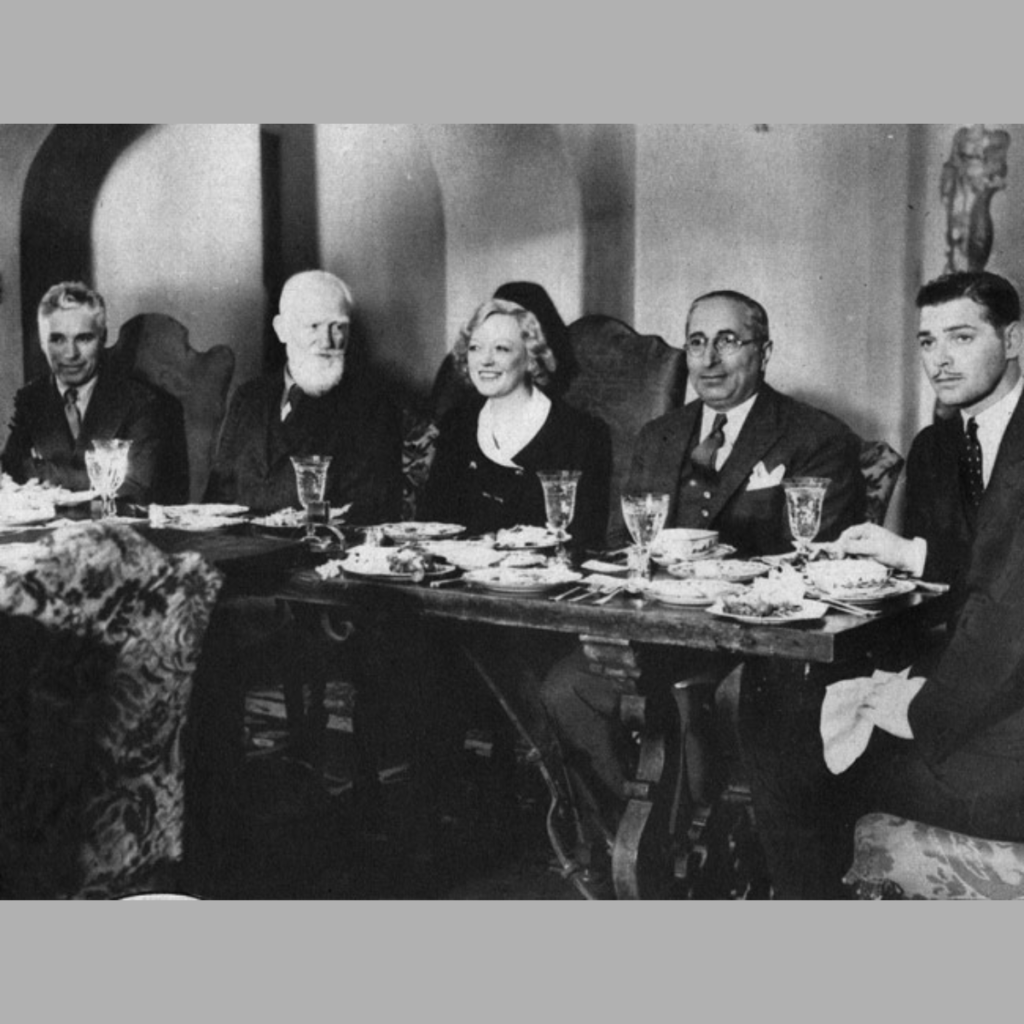

William Randolph Hearst at table in his castle.
Out in San Simeon, California, the Hearst Castle Preservation Foundation held its annual weekend benefit at the Hearst Castle. If you don’t know about the Hearst castle, officially known as La Cuesta Encantada (“The Enchanted Hill”), you’re missing the story about a man who lived a life like a lot of us might have imagined for ourselves when we were children and building castles in the sand by the beach (only to be swept away by the tide).
I’d been aware of Hearst’s palace since I was a kid reading about it in movie magazines as well as well as the major national weekly magazines because William Randolph Hearst entertained major Hollywood stars as well as a bevy of famous names at weekend parties, from presidents, movie stars, princes and even George Bernard Shaw — who couldn’t resist an invitation to the house (palace) that “God would have built for himself if he had the money.”

Charlie Chaplin, George Bernard Shaw, Marion Davies, Louis B. Mayer, and Clark Gable at Hearst Castle in 1933. Ella Strong Denison Library
Sitting on a mountaintop of an estate, San Simeon — which is how the property was often referred to in the press — was only one of Hearst’s several residences (four in California). Halfway between Los Angeles and San Francisco, with 50 miles of shorefront on the Pacific, and 40 miles inland, it comprised 425,000 acres (or 250,000 — depending on the source).

George Hearst, c. 1891.
The original property known as the Hearst Farm was acquired in the second half of the 19th century by his father George Hearst, the mining tycoon. As his mining prospects grew, so did his taste for real estate — including a million-acre mining and oil and ranch property in Mexico. The Hearsts and their only son William visited San Simeon fairly frequently. This was back when California was still the wild west and the Gold Rush was beginning to grow and prosper.
George Hearst died at age 70 in 1891, leaving his huge fortune solely to his wife Phoebe, who was twenty years younger than her husband. Phoebe, a modern woman, grew up on a farm in Missouri not far from where George grew up — although they’d never met. In time she would become a suffragette as well as a feminist and a philanthropist. A major supporter of education, she was known as the “Mother of the University of California” creating scholarships for women and funded an international competition for a master plan for the Berkeley campus. Among her many public gifts, she also co-founded the National Cathedral School in Washington when George Hearst became a Senator from California.

Phoebe Hearst, “Mother of the University of California” and William Randolph Hearst.
The Hearst’s only child William had his father’s sense of independence and adventure. When George died in 1891 (William was 28), he left his entire vast estate of famous American mining and real estate interests (as well as a million-acre property in Mexico) to Phoebe. When she died in 1919 at age 77, William, then in his mid-fifties became the sole owner of it all. By that time he was publisher of the largest chain of daily newspapers in America and nationally famous as a politician. A Democrat, he also ran for public office and was twice elected to the House of Representatives. He also ran for President, for Governor, for Mayor and lost every race.
In 1903 married to Millicent Wilson whom he first saw on a vaudeville stage in New York where she and her sister were performing an act with their father. It was a time (pre-electronics) when Broadway was jammed with theaters, and theatre stars outshone any movie star.
Hearst loved the theatre and often visited the shows including musicals and burlesque. The two Wilson sisters took his fancy, and were soon both on the arm of Mr. Hearst frequently, a trio. When he married Millicent, her sister and their father moved in with them where their five sons grew up in a four story 30-room apartment on West 86th Street and Riverside Drive.

William Randolph Hearst with his wife, Millicent, in 1923. Courtesy Of Library of Congress/PBS
A few years into his marriage to Millicent, he met Marion Davies, a very pretty 19-year-old actress in a Broadway show. He was 53. It was one of those decisive moments in a man’s life. He saw Marion as much as possible while continuing to be a husband and father.

William Randolph Hearst with Marion Davies.
But after three or four years, it was no longer a “secret” to anybody who knew him, including Millicent. It was publicly well known – even nationally – that he spent most of his time living with Marion Davies in an era when that kind of relationship was never publicly revealed and always considered scandalous.
However, everyone understood; it was what he wanted. Millicent sued for divorce. It was almost settled except she had one more request: she wanted the Cosmopolitan Magazine. No; the divorce never occurred. She remained well supported with her children and their lives and saw her husband very infrequently. Millicent Hearst made a better life for herself without him.
Marion remained his fulltime companion for the rest of his life, living mainly in Beverly Hills, as well as the beach at Santa Monica, and New York (the Ritz Tower on 57th Street and Park Avenue which was said to have been built for her).
Which, before I forget, brings us to this past weekend at Hearst Castle. It was William’s mother Phoebe’s passing that launched the idea for a great house on a hilltop. It was all his now. He was, by then, a prince or a baron of sorts, possessing the great fortune as well as a hugely successful newspaper chain, and the film business of Maid Marion who clearly was the love the man’s long life. He hired Julia Morgan, a prominent woman architect whom Phoebe had used for a public building she gave. The relationship between the two lasted for the rest of their lives.

William Randolph Hearst with Hearst Castle architect Julia Morgan.
Photo: Courtesy of Marc Wanamaker / Bison Archives
La Cuesta Encantada. Back in the mid-’70s, before I lived out there, I had gone out to Los Angeles and also drove up to Monterey to see an old friend. I passed by San Simeon as the property is oceanside. I’d already seen many photos of the castle and the famous swimming pool, but I had never seen the view of it sitting mountaintop from a distance of two or three miles away. It had a glamor to these eyes, having read about the social life. Calling me back. I decided to visit on my return to LA.
It was a sunny summer’s day in San Simeon. Cars were parked off the highway and a bus took the visitors up the two mile long driveway to the edge of the foundation’s walls. There was a line of about 30 or 40 waiting on the stone steps leading up by the guesthouses to the casa’s broad terrace. And then you arrive. It is a monument to a man — his personality, his self-regard and his vivid imagination which he could afford to support. I could only think Man will always build monuments to himself (or occasionally herself). It is notable that he hired Miss Morgan, one of the very few female architects in the world. And a very conservative, all-business lady.

La Cuesta Encantada atop the mountain.
The tours of the house and the grounds and the zoo and the swimming pools and the bedrooms and the vast dining hall, you could only imagine yourself living/staying in a great palace in a faraway land overlooking the Pacific. It’s a masterpiece of American grandeur incorporating centuries of art and culture right up to the movie screen. Walking through the vast yet oddly homey atmosphere, you can see how a weekend party in a house with 53 bedrooms and going full tilt, must have been an amazing experience for anyone.
Although there were stories usually about how “the old man” didn’t approve of drinking — and especially with his devoted mistress who evidently had bottles hidden all over the building. You got the picture of an extraordinary experience as a guest.

The Neptune Pool, circa 1939, was a setting for lively parties. Pomona Public Library

Party scenes from Hearst Castle.
I tend to look at people in terms of the father and mother from which they came. In my lifetime, William Randolph Hearst was a prominent American across the first half of the 20th century. He was always a famous public character, tall and serious And old. He was very active publicity-wise on several fronts. At an age and a time when men of his financial stature preferred anonymity, he was press and in charge. He possessed the special power of owners of the press: people read them closely everyday. He fathered a fairly large family and many of his heirs are still enjoying the ambitions of the father and the son.
Later in recounting my visit to La Cuesta Encantada to an old professor of mine, a man who has vast knowledge of American and European history, he too related a story about one of the weekends at San Simeon which included Dorothy Parker — who at the time, had a column in one of the Hearst papers. At the end of the weekend, however, before Dorothy departed, she was informed that her services at the paper would no longer be needed.
In her scalding disappointment, with her bags packed, she wrote out the following and pinned it on Marion Davies’ bedroom door:
Upon my honor
I’ve seen the Madonner
Set high in a golden niche.
But beyond this door,
Lies the beautiful whore,
Of the world’s worst son of a bitch

Hearst Castle at night. Photograph by Dani Lavi.




